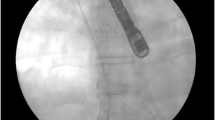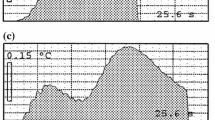Abstract
Purpose
Bicaval dual-lumen catheters allow for single-site cannulation venovenous extracorporeal gas exchange and facilitate early mobilization of patients. Using these catheters blood is drained from the superior and inferior venae cavae, pumped through a respiratory membrane, and returned into the right atrium. The insertion of these catheters is challenging as their correct positioning is fundamental to reduce recirculation and avoid severe complications. We describe here a new technique for the positioning of bicaval dual-lumen catheters.
Materials and methods
The right internal jugular vein was percutaneously cannulated in nine sheep. The distance between skin and tricuspid valve was measured from the point of pressure change in the waveform of a Swan–Ganz catheter being retracted from the right ventricle into the right atrium. The atrium-tricuspid valve-ventricle axis was determined by observing the fluctuations of the tip of the Swan–Ganz entering the ventricle during fluoroscopy. A bicaval dual-lumen catheter was placed on the basis of these evaluations and connected to an extracorporeal respiratory support system.
Results
The position of the catheter was verified at necropsy approximately 18 h after insertion. In all cases the catheter was correctly placed, with the central port situated in front of the tricuspid valve.
Conclusions
The described technique may help to position bicaval dual-lumen catheters for venovenous extracorporeal gas exchange without the use of transesophageal echocardiography or contrast media during fluoroscopy.


Similar content being viewed by others
References
Javidfar J, Brodie D, Wang D, Ibrahimiye AN, Yang J, Zwischenberger JB, Sonett J, Bacchetta M (2011) Use of bicaval dual-lumen catheter for adult venovenous extracorporeal membrane oxygenation. Ann Thorac Surg 91:1763–1768
Lazar DA, Cass DL, Olutoye OO, Kim ES, Welty SE, Fernandes CJ, Lee TC (2012) Venovenous cannulation for extracorporeal membrane oxygenation using a bicaval dual-lumen catheter in neonates. J Pediatr Surg 47:430–434
Turner DA, Cheifetz IM, Rehder KJ, Williford WL, Bonadonna D, Banuelos SJ, Peterson-Carmichael S, Lin SS, Davis D, Zaas D (2011) Active rehabilitation and physical therapy during extracorporeal membrane oxygenation while awaiting lung transplantation: a practical approach. Crit Care Med 39:2593–2598
Wang D, Zhou X, Liu X, Sidor B, Lynch J, Zwischenberger JB (2008) Wang–Zwische double lumen cannula—toward a percutaneous and ambulatory paracorporeal artificial lung. ASAIO J 54:606–611
Korver EP, Ganushchak YM, Simons AP, Donker DW, Maessen JG, Weerwind PW (2012) Quantification of recirculation as an adjuvant to transthoracic echocardiography for optimization of dual-lumen extracorporeal life support. Intensive Care Med 38:906–909
van Heijst AF, van der Staak FH, de Haan AF, Liem KD, Festen C, Geven WB, van de Bor M (2001) Recirculation in double lumen catheter veno-venous extracorporeal membrane oxygenation measured by an ultrasound dilution technique. ASAIO J 47:372–376
Javidfar J, Wang D, Zwischenberger JB, Costa J, Mongero L, Sonett J, Bacchetta M (2011) Insertion of bicaval dual-lumen extracorporeal membrane oxygenation catheter with image guidance. ASAIO J 57:203–205
Trimlett RH, Cordingley JJ, Griffiths MJ, Price S, Hunter DN, Finney SJ (2011) A modified technique for insertion of dual-lumen bicaval cannulae for venovenous extracorporeal membrane oxygenation. Intensive Care Med 37:1036–1037
Hirose H, Yamane K, Marhefka G, Cavarocchi N (2012) Right ventricular rupture and tamponade caused by malposition of the Avalon cannula for venovenous extracorporeal membrane oxygenation. J Cardiothorac Surg 7:36
de Bucourt M, Teichgraber UK (2012) Image guided placement of extracorporeal life support through bicaval dual-lumen venovenous membrane oxygenation in an interventional radiology setting-initial experience. J Vasc Access 13:221–225
Tabak B, Elliott CL, Mahnke CB, Tanaka LY, Ogino MT (2012) Transthoracic echocardiography visualization of bicaval dual-lumen catheters for veno-venous extracorporeal membrane oxygenation. J Clin Ultrasound 40:183–186
Crotti S, Lissoni A, Tubiolo D, Azzari S, Tarsia P, Caspani L, Gattinoni L (2012) Artificial lung as an alternative to mechanical ventilation in COPD exacerbation. Eur Respir J 39:212–215
Fuehner T, Kuehn C, Hadem J, Wiesner O, Gottlieb J, Tudorache I, Olsson KM, Greer M, Sommer W, Welte T, Haverich A, Hoeper MM, Warnecke G (2012) Extracorporeal membrane oxygenation in awake patients as bridge to lung transplantation. Am J Respir Crit Care Med 185:763–768
Hoste EA, Doom S, De Waele J, Delrue LJ, Defreyne L, Benoit DD, Decruyenaere J (2011) Epidemiology of contrast-associated acute kidney injury in ICU patients: a retrospective cohort analysis. Intensive Care Med 37:1921–1931
Joannidis M, Metnitz B, Bauer P, Schusterschitz N, Moreno R, Druml W, Metnitz PG (2009) Acute kidney injury in critically ill patients classified by AKIN versus RIFLE using the SAPS 3 database. Intensive Care Med 35:1692–1702
Acknowledgments
We are grateful to Mr. Glen Gueller for assistance with the illustrations used in this manuscript. This study was supported in part by the US Army Combat Casualty Care Research Program.
Author information
Authors and Affiliations
Corresponding author
Additional information
The opinions or assertions contained herein are the private views of the authors and are not to be construed as official or as reflecting the views of the Department of the Army or the Department of Defense.
Rights and permissions
About this article
Cite this article
Langer, T., Vecchi, V., Belenkiy, S.M. et al. Pressure-guided positioning of bicaval dual-lumen catheters for venovenous extracorporeal gas exchange. Intensive Care Med 39, 151–154 (2013). https://doi.org/10.1007/s00134-012-2751-5
Received:
Accepted:
Published:
Issue Date:
DOI: https://doi.org/10.1007/s00134-012-2751-5




